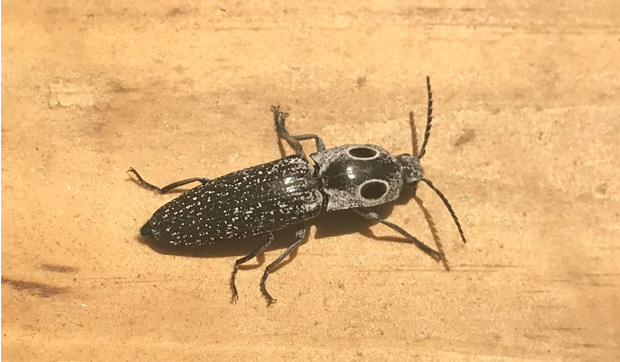Measuring up to 1 3/4 in. and marked with prominent ‘eyes,’ the eyed click beetle can be found in mature oak woodlands throughout our area. Photo supplied by Sue and Jim Mikowski.
Good Natured: Two-eyed Click Beetle
June 16, 2023
It’s funny how years of naturalist training can fly right out the window when a truly unique specimen appears.
My friends Sue and Jim Mikowski sent me a few photos of a beetle they’d found outside their home in Elburn and requested some help with identification. Now normally when ID-ing beetles there are a few key traits to focus in on-relative size, shape of antennae and elytra (a.k.a. wing covers) …
Instead though I took one look at the insect’s markings and went 100% fairy tale. Just like when Little Red Riding Hood saw the wolf in Grandma’s nightie, I couldn’t help but shout, “My, what big eyes you have!”
I suppose if I hadn’t been so awestruck I might’ve taken the time to add some air quotes and exclaim “My, what big ‘eyes’ you have!” But it can be hard to self edit when presented with such wonderment.
The creature featured in Sue and Jim’s photos is an eyed click beetle, Alaus oculatus. Even without training, naturalist or otherwise, it’s easy to see that eyes, or “eyes,” figure prominently in this insect’s life history. The eyespots on its back are so prominent they’re part of both the scientific and common names, the latter of which also include eastern eyed elater and, more obscurely, owl beetle.
Eyespots themselves aren’t all that unique-lots of butterflies and moths have them-but those on oculatus are special indeed. They’re not just black, they’re super black! Well, almost.
Super black is a designation whereby certain dark-pigmented structures-often, in nature, feathers-absorb almost all the available light. For example the male bird of paradise, a black bird if there ever was one, has feather filaments that bend upward and capture 99.95% of the light hitting them.
Not being birds, eyed click beetles have instead cone-shaped microtubules, that is, teensy hairs (setae) inside their white eye rings that lie at a slight angle and absorb 96.1% of ambient light. The resulting effect is eyespots so dark and conspicuous-menacing, even–that predators presumably look elsewhere for prey. Meanwhile, the actual eyes are small and up front, right where you’d expect beetle eyes to be.
Although boldly marked, these insects camouflage surprisingly well in the woodlands they call home. Eyespots aside, the rest of the body is mottled with fine gray and white specks; they blend in well against bark and, I’d imagine, also when placed on an old graniteware cooking vessel. (Note to self: See if Mom’s graniteware roaster is still around and save for future click beetle research.)
As cool as those eyespots are though, they’re only about half of the click beetle’s amazing story. The other half can be found in the “click” part of the name.
As members of the Elateridae, or click beetle family, these insects are equipped with mechanisms so unique they’ve been studied by entomologists and engineers alike. Placed on its back, the beetle coordinates hinged body parts and peg-and-latch structures to store and release energy, creating a phenomenon engineers call snap buckling. In short, they fling upward with an audible click. (For a really comprehensive explanation, check out this webpage: https://interestingengineering.com/science/scientists-study-incredible-energy-of-click-beetles-jump-motion)
Details aside, this feature is a lot of fun to play with. Should you be lucky enough to find an eyed click beetle, be sure and turn it upside down and watch what happens next. Or hold it in your hand and feel the powerful clicks as it tries to escape. Super cool!
As adults eyed click beetles are peaceable sort, thought to feed on pollen and nectar. But this trait stands in stark contrast to their immature stage where, known as wireworms, they are described as voracious predators. During this life phase, which can last up to five years, their prey includes other beetle larvae, maggots, caterpillars…basically anything that can be found creeping about beneath the bark of fallen oak, cherry and apple trees.
(Side note: While it’s perfectly safe and dare I say gleefully entertaining to play with adult eyed click beetles, do exercise caution around their offspring. The same powerful jaws that can annihilate a wood-boring cerambycid beetle larva can also give fingers a mighty pinch.)
Beetles come in all shapes and sizes; in fact their order, Coleoptera, is the largest in the world and represents about 40% of all known insect species. They run the gamut in terms of color and degrees of helpfulness. The eyed click beetle, with its striking pattern, intriguing clicks and beneficial larval stage, checks a lot of boxes for bug fanciers and nature lovers alike.
As Goldilocks would say, this one is just right!
Pam Otto is the outreach ambassador for the St. Charles Park District. She can be reached at potto@stcparks.org.

